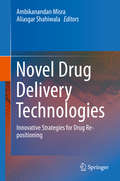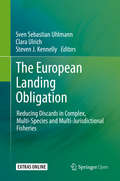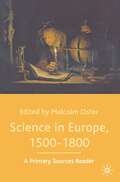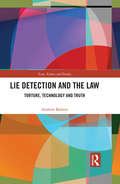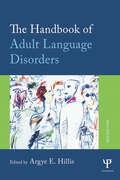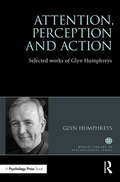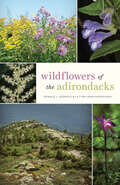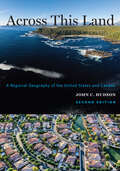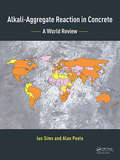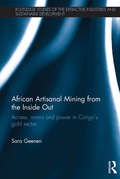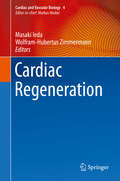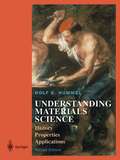- Table View
- List View
The Making of Modern Science: Science, Technology, Medicine and Modernity: 1789 - 1914 (History of Science #2)
by David KnightOf all the inventions of the nineteenth century, the scientist is one of the most striking. In revolutionary France the science student, taught by men active in research, was born; and a generation later, the graduate student doing a PhD emerged in Germany. In 1833 the word 'scientist' was coined; forty years later science (increasingly specialised) was a becoming a profession. Men of science rivalled clerics and critics as sages; they were honoured as national treasures, and buried in state funerals. Their new ideas invigorated the life of the mind. Peripatetic congresses, great exhibitions, museums, technical colleges and laboratories blossomed; and new industries based on chemistry and electricity brought prosperity and power, economic and military. Eighteenth-century steam engines preceded understanding of the physics underlying them; but electric telegraphs and motors were applied science, based upon painstaking interpretation of nature. The ideas, discoveries and inventions of scientists transformed the world: lives were longer and healthier, cities and empires grew, societies became urban rather than agrarian, the local became global. And by the opening years of the twentieth century, science was spreading beyond Europe and North America, and women were beginning to be visible in the ranks of scientists. Bringing together the people, events, and discoveries of this exciting period into a lively narrative, this book will be essential reading both for students of the history of science and for anyone interested in the foundations of the world as we know it today.
Novel Drug Delivery Technologies: Innovative Strategies for Drug Re-positioning
by Ambikanandan Misra Aliasgar ShahiwalaThe application of drug delivery is a valuable, cost-effective lifecycle management resource. By endowing drugs with new and innovative therapeutic benefits, drug delivery systems extend products’ profitable lifecycle, giving pharmaceutical companies competitive and financial advantages, and providing patients with improved medications. Formulation development is now being used to create new dosage forms for existing products, which not only reduces the time and expense involved in new drug development, but also helps with regard to patent protection and bypassing existing patents. Today’s culture demands convenience, a major factor determining adherence to drug therapy. Over the past few years, patient convenience-oriented research in the field of drug delivery has yielded a range of innovative drug-delivery options. As a result, various drug-delivery systems, including medicated chewing gums, oral dispersible tablets, medicated lozenges and lollipops, have now hit the market and are very popular. These dosage forms offer a highly convenient way to dose medications, not only for special population groups with swallowing difficulties, such as children and the elderly, but for the general populace as well. This book provides valuable insights into a number of formulation design approaches that are currently being used, or could be used, to provide new benefits from existing drug molecules.
The European Landing Obligation: Reducing Discards In Complex, Multi-species And Multi-jurisdictional Fisheries
by Sven Sebastian Uhlmann Clara Ulrich Steven J. KennellyThis open access book provides a comprehensive examination of the European Landing Obligation policy from many relevant perspectives. It includes evaluations of its impacts at economical, socio-cultural, ecological and institutional levels. It also discusses the feasibility and benefits of several potential mitigation strategies. The book was timely published, exactly at the time where the Landing Obligation was planned to be fully implemented. This book is of significant interest to all stakeholders involved, but also to the general public of Europe and to other jurisdictions throughout the world that are also searching for ways to deal with by-catch and discard issues.
Science in Europe, 1500-1800: A Primary Sources Reader
by Malcolm OsterThe period from Copernicus to Newton witnessed a Scientific Revolution which eventually led to modern science and both built upon and sharply challenged the earlier natural philosophies of the classical world. Science in Europe, 1500-1800: A Primary Sources Readeroffers a fascinating picture of the world of the scientific revolution through the eyes of those involved. This selection of primary sources is geographically inclusive, including often-neglected areas such as Spain, Scandinavia and central-eastern Europe, and thematically wide-ranging, illustrating early modern Europe's interplay of social, cultural and intellectual traditions.A key resource for all students and teachers of the history of science, Malcolm Oster's masterly collection offers an introduction to the conceptual and institutional foundations of modern science.This volume can be used alongside or independently of its companion volume, Science in Europe: 1500-1800: A Secondary Sources Reader (also edited by Malcolm Oster).
Neurotechnology and Direct Brain Communication: New insights and responsibilities concerning speechless but communicative subjects (Explorations in Cognitive Psychology)
by Michele Farisco Kathinka EversNeurotechnology and Direct Brain Communication focuses on recent neuroscientific investigations of infant brains and of patients with disorders of consciousness (DOC), both of which are at the forefront of contemporary neuroscience. The prospective use of neurotechnology to access mental states in these subjects, including neuroimaging, brain simulation, and brain computer interfaces, offers new opportunities for clinicians and researchers, but has also received specific attention from philosophical, scientific, ethical, and legal points of view. This book offers the first systematic assessment of these issues, investigating the tools neurotechnology offers to care for verbally non-communicative subjects and suggesting a multidisciplinary approach to the ethical and legal implications of ordinary and experimental practices. The book is divided into three parts: the first and second focus on the scientific and clinical implications of neurological tools for DOC patient and infant care. With reference to these developments, the third and final part presents the case for re-evaluating classical ethical and legal concepts, such as authority, informed consent, and privacy. Neurotechnology and Direct Brain Communication will appeal to researchers and postgraduate students in the fields of cognitive science, medical ethics, medical technology, and the philosophy of the mind. With implications for patient care, it will also be a useful resource for clinicians, medical centres, and health practitioners.
Handbook of Transitions to Energy and Climate Security (Routledge International Handbooks)
by Robert E. LooneyAn original contribution to our understanding of a phenomenon that is reshaping the world, this title thoroughly discusses the transformation of the energy security policy arena brought on by two dramatic developments – the increased potential availability of energy in many parts of the world on the supply side, and on the demand side increasing concerns over the harmful effects on the environment brought on by the use of fossil fuels. An in depth discussion specifically focuses on what energy security means to different countries, and examines which of those countries appear to be managing their energy/climate transitions successfully and which are having a more difficult time adapting to the new environment. Part 1 introduces the topic, covering the main themes and provides an overview of the chapters Part 2 provides a framework for policy evaluation, considering the evolving factors affecting energy security and the energy/climate policy trilemma Parts 3 to 6 discuss energy transitions in the carbon producing countries (Saudi Arabia, Canada, Iran, Russia, Mexico), in intermediate carbon/producing/consuming countries (China, United States, UK, Brazil, Argentina, South Africa), in carbon consuming countries (Germany, Japan, South Korea, Israel, India, Spain) and finally in carbon reduction countries (France, Denmark, Switzerland) Part 7 looks at attempts at regional/international cooperation Part 8 considers the prospects for the future, examining technological breakthroughs. This title builds on the theme of unfolding energy transformations driven by, but increasingly constrained by climate/environmental considerations. It is ideal for researchers and students in the areas of environmental politics and policy, climate change, and energy and climate security, as well as for academics and professionals.
Handbook of Transitions to Energy and Climate Security (Routledge International Handbooks)
by Robert E. LooneyAn original contribution to our understanding of a phenomenon that is reshaping the world, this title thoroughly discusses the transformation of the energy security policy arena brought on by two dramatic developments – the increased potential availability of energy in many parts of the world on the supply side, and on the demand side increasing concerns over the harmful effects on the environment brought on by the use of fossil fuels. An in depth discussion specifically focuses on what energy security means to different countries, and examines which of those countries appear to be managing their energy/climate transitions successfully and which are having a more difficult time adapting to the new environment. Part 1 introduces the topic, covering the main themes and provides an overview of the chapters Part 2 provides a framework for policy evaluation, considering the evolving factors affecting energy security and the energy/climate policy trilemma Parts 3 to 6 discuss energy transitions in the carbon producing countries (Saudi Arabia, Canada, Iran, Russia, Mexico), in intermediate carbon/producing/consuming countries (China, United States, UK, Brazil, Argentina, South Africa), in carbon consuming countries (Germany, Japan, South Korea, Israel, India, Spain) and finally in carbon reduction countries (France, Denmark, Switzerland) Part 7 looks at attempts at regional/international cooperation Part 8 considers the prospects for the future, examining technological breakthroughs. This title builds on the theme of unfolding energy transformations driven by, but increasingly constrained by climate/environmental considerations. It is ideal for researchers and students in the areas of environmental politics and policy, climate change, and energy and climate security, as well as for academics and professionals.
Science vs. Religion: Intelligent Design And The Problem Of Evolution
by Steve FullerFor centuries, science and religion have been portrayed as diametrically opposed. In this provocative new book, Steve Fuller examines the apparent clash between science and religion by focusing on the heated debates about evolution and intelligent design theory. In so doing, he claims that science vs. religion is in fact a false dichotomy. For Fuller, supposedly intellectual disputes, such as those between creationist and evolutionist accounts of life, often disguise other institutionally driven conflicts, such as the struggle between State and Church to be the source of legitimate authority in society. Nowadays many conservative anti-science groups support intelligent design theory, but Fuller argues that the theory's theological roots are much more radical, based on the idea that humans were created to fathom the divine plan, perhaps even complete it. He goes on to examine the unique political circumstances in the United States that make the emergence of intelligent design theory so controversial, yet so persistent. Finally, he considers the long-term prognosis, arguing that the future remains very much undecided as society reopens the question of what it means to be human. This book will appeal to all readers intrigued by the debates about creationism, intelligent design and evolution, especially those looking for an intellectually exciting confrontation with the politics and promise of intelligent design theory.
New Frontiers in Science and Technology Studies
by Steve FullerSteve Fuller has a reputation for setting the terms of debate within science and technology studies. In his latest book, New Frontiers in Science and Technology Studies he charts the debates likely to be of relevance in the coming years. Should science and technology be treated as separate entities? What impact has globalization had on science and technology? Can science be clearly distinguished from other forms of knowledge? Does the politicization of science really matter? Is there a role for the social regulation of scientific inquiry? Should we be worried about research fraud? These questions are explored by examining an array of historical, philosophical and contemporary sources. Attention is paid, for example, to the Bruno Latour's The Politics of Nature as a model for science policy, as well as the global controversy surrounding Bjorn Lomborg's The Sceptical Environmentalist, which led to the dismantling and re-establishment of the Danish national research ethics board. New Frontiers in Science and Technology Studies will appeal strongly to scholars and advanced undergraduate and graduate students in courses concerned with the social dimensions of science and technology, and anyone who cares about the future of science.
Identity Politics and Elections in Malaysia and Indonesia: Ethnic Engineering in Borneo (Routledge Contemporary Southeast Asia Series)
by Karolina PrasadIn recent social research, ethnicity has mostly been used as an explanatory variable. It was only after it was agreed that ethnicity, in itself, is subject to change, were the questions of how and why it changes, possible to answer. This multiplicity of ethnic identities requires that we think of each society as one with multiple ethnic dimensions, of which any can become activated in the process of political competition - and sometimes several of them within a short period of time. Focusing on Malaysia and Indonesia, this book traces the variations of ethnic identity by looking at electoral strategies in two sub-national units. It shows that ethnic identities are subject to change - induced by calculated moves by political entrepreneurs who use identities as tools to maximize their chances of winning elections or expanding support base - and highlights how political institutions play an enormous role in shaping the modes and dynamics of these ethno-political manipulations. The book suggests that in societies where ethnic identities are activated in politics, instead of analysing politics with ethnic distribution as an independent variable, ethnic distribution can be taken as the dependent variable, with political institutions being the explanatory one. It examines the problems of voters’ behaviour, and parties’ and candidates’ strategy in a polity that is, to a significant extent, driven by ethnic relations. Pushing the boundaries of qualitative research on Southeast Asian politics by placing formal institutions at the centre of its analysis, this book will be of interest to students and scholars of Southeast Asian Politics, Race and Ethnic Studies, and International Relations.
Lie Detection and the Law: Torture, Technology and Truth (Law, Science and Society)
by Andrew BalmerThis book develops a sociological account of lie detection practices and uses this to think about lying more generally. Bringing together insights from sociology, social history, socio-legal studies and science and technology studies (STS), it explores how torture and technology have been used to try to discern the truth. It examines a variety of socio-legal practices, including trial by ordeal in Europe, the American criminal jury trial, police interrogations using the polygraph machine, and the post-conviction management of sex offenders in the USA and the UK. Moving across these different contexts, it articulates how uncertainties in the use of lie detection technologies are managed, and the complex roles they play in legal spaces. Alongside this story, the book surveys some of the different ways in which lying is understood in philosophy, law and social order. Lie Detection and the Law will be of interest to STS researchers, socio-legal scholars, criminologists and sociologists, as well as others working at the intersections of law and science.
Human Behaviour Analysis Using Intelligent Systems (Learning and Analytics in Intelligent Systems #6)
by D. Jude HemanthHuman–computer interaction (HCI) is one of the most significant areas of computational intelligence. This book focuses on the human emotion analysis aspects of HCI, highlighting innovative methodologies for emotion analysis by machines/computers and their application areas. The methodologies are presented with numerical results to enable researchers to replicate the work. This multidisciplinary book is useful to researchers and academicians, as well as students wanting to pursue a career in computational intelligence. It can also be used as a handbook, reference book, and a textbook for short courses.
Studies in Science Education in the Asia-Pacific Region (Routledge Research in Education)
by Alister Jones Cathy Buntting May May Hung ChengConsistent with international trends, there is an active pursuit of more engaging science education in the Asia-Pacific region. The aim of this book is to bring together some examples of research being undertaken at a range of levels, from studies of curriculum and assessment tools, to classroom case studies, and investigations into models of teacher professional learning and development. While neither a comprehensive nor definitive representation of the work that is being carried out in the region, the contributions—from China, Hong Kong, Taiwan, Korea, Japan, Singapore, Australia, and New Zealand—give a taste of some of the issues being explored, and the hopes that researchers have of positively influencing the types of science education experienced by school students. The purpose of this book is therefore to share contextual information related to science education in the Asia-Pacific region, as well as offering insights for conducting studies in this region and outlining possible questions for further investigation. In addition, we anticipate that the specific resources and strategies introduced in this book will provide a useful reference for curriculum developers and science educators when they design school science curricula and science both pre-service and in-service teacher education programmes. The first section of the book examines features of science learners and learning, and includes studies investigating the processes associated with science conceptual learning, scientific inquiry, model construction, and students’ attitudes towards science. The second section focuses on teachers and teaching. It discusses some more innovative teaching approaches adopted in the region, including the use of group work, inquiry-based instruction, developing scientific literacy, and the use of questions and analogies. The third section reports on initiatives related to assessments and curriculum reform, including initiatives associated with school-based assessment, formative assessment strategies, and teacher support accompanying curriculum reform.
The Handbook of Adult Language Disorders
by Argye E. HillisThe Handbook of Adult Language Disorders is the essential guide to the scientific and clinical tenets of aphasia study and treatment. It focuses on how language breaks down after focal brain damage, what patterns of impairment reveal about normal language, and how recovery can be optimally facilitated. It is unique in that it reviews studies from the major disciplines in which aphasia research is conducted—cognitive neuropsychology, linguistics, neurology, neuroimaging, and speech-language pathology—as they apply to each topic of language. For each language domain, there are chapters devoted to theory and models of the language task, the neural basis of the language task (focusing on recent neuroimaging studies) and clinical diagnosis and treatment of impairments in that domain. In addition, there is broad coverage of approaches to investigation and treatment from leading experts, with several authors specializing in two or more disciplines. This second edition focuses on characterizing the cognitive and neural processes that account for each variant of aphasia as a first step toward developing effective rehabilitation, given that aphasia is one of the most common and disabling consequences of stroke. The best and most authoritative handbook in the field, The Handbook of Adult Language Disorders is the definitive reference for clinicians and researchers working in the scientific investigation of aphasia.
Attention, Perception and Action: Selected Works of Glyn Humphreys (World Library of Psychologists)
by Glyn W. HumphreysIn the World Library of Psychologists series, international experts themselves present career-long collections of what they judge to be their finest pieces - extracts from books, key articles, salient research findings, and their major practical theoretical contributions. Glyn Humphreys is an internationally renowned cognitive neuropsychologist with research interests covering object recognition and its disorders, visual word recognition, object and spatial attention, the effects of action on cognition, and social cognition. Within the field of Psychology he has won a number of prestigious awards, including the Spearman Medal, the President’s Award of the British Psychological Society, and the Donald Broadbent Prize from the European Society for Cognitive Psychology. This collection reflects the different directions in his work and approaches which have been adopted. It will enable the reader to trace key developments in cognitive neuropsychology in a period of rapid change over the last thirty years. A newly written introduction contextualises the selection in relation to changes in the field during this time. Attention, Perception and Action will be invaluable reading for students and researchers in visual cognition, cognitive neuropsychology and vision neuroscience.
Advances in Biolinguistics: The Human Language Faculty and Its Biological Basis
by Koji Fujita Cedric A. BoeckxBiolinguistics is a highly interdisciplinary field that seeks the rapprochement between linguistics and biology. Linking theoretical linguistics, theoretical biology, genetics, neuroscience and cognitive psychology, this book offers a collection of chapters situating the enterprise conceptually, highlighting both the promises and challenges of the field, and chapters focusing on the challenges and prospects of taking interdisciplinarity seriously. It provides concrete illustrations of some of the cutting-edge research in biolinguistics and piques the interest of undergraduate students looking for a field to major in and inspires graduate students on possible research directions. It is also meant to show to specialists in adjacent fields how a particular strand of theoretical linguistics relates to their concerns, and in so doing, the book intends to foster collaboration across disciplines. Chapter 1 of this book is freely available as a downloadable Open Access PDF at http://www.taylorfrancis.com under a Creative Commons Attribution-Non Commercial-No Derivatives (CC-BY-NC-ND) 4.0 license.
Wildflowers of the Adirondacks (PDF)
by Lytton Musselman Donald LeopoldCovering more than six million acres of protected wilderness, the Adirondacks, with their landscape of high peaks, verdant wetlands, majestic trees, and lush carpets of flowers, is a pristine paradise for nature lovers. The only available identification guide to the Adirondack region's wildflowers, this comprehensive resource is packed with more than 300 gorgeous color images, one to represent almost every flower commonly found in this huge range. Revealing the stunning diversity of Adirondack wildflowers, from goldenrod and marsh blue violet to cattails and hellebore, the book includes • detailed botanical species accounts, arranged by flower color• images of each flower that highlight key features for easy ID• information about each species' natural history• descriptions of the region's upland, wetland, and aquatic habitats• a special section on the nearly 40 terrestrial orchid species found in the AdirondacksWritten by Donald J. Leopold and Lytton John Musselman, skilled botanists and the foremost authorities on these plants, this superior quality guide will appeal to residents of and visitors to the Adirondacks and northeastern mountains, including wildlife professionals, citizen scientists, backpackers, campers, photographers, bird watchers, artists, and wild food foragers.
Wildflowers of the Adirondacks
by Lytton Musselman Donald LeopoldCovering more than six million acres of protected wilderness, the Adirondacks, with their landscape of high peaks, verdant wetlands, majestic trees, and lush carpets of flowers, is a pristine paradise for nature lovers. The only available identification guide to the Adirondack region's wildflowers, this comprehensive resource is packed with more than 300 gorgeous color images, one to represent almost every flower commonly found in this huge range. Revealing the stunning diversity of Adirondack wildflowers, from goldenrod and marsh blue violet to cattails and hellebore, the book includes • detailed botanical species accounts, arranged by flower color• images of each flower that highlight key features for easy ID• information about each species' natural history• descriptions of the region's upland, wetland, and aquatic habitats• a special section on the nearly 40 terrestrial orchid species found in the AdirondacksWritten by Donald J. Leopold and Lytton John Musselman, skilled botanists and the foremost authorities on these plants, this superior quality guide will appeal to residents of and visitors to the Adirondacks and northeastern mountains, including wildlife professionals, citizen scientists, backpackers, campers, photographers, bird watchers, artists, and wild food foragers.
Across This Land: A Regional Geography of the United States and Canada (Creating the North American Landscape)
by John HudsonBased on decades of research and written in clear, concise prose by one of the foremost geographers in North America, John C. Hudson's Across This Land is a comprehensive regional geography of the North American continent. Dividing the terrain into ten regions, which are then subdivided into twenty-seven smaller areas, Hudson's brisk narrative reveals the dynamic processes of each area's distinctive place-specific characteristics. Focusing on how human activities have shaped and have been shaped by the natural environment, Hudson considers physical, political, and historical geography. He also highlights related topics, including resource exploitation, economic development, and population change. Praised in its first edition as a readable and reliable interpretation of United States and Canadian geography, the revised Across This Land retains these strengths while adding substantial new material. Incorporating the latest available population and economic data, this thoroughly updated edition includes• reflections on new developments, such as resource schemes, Native governments in Atlantic Canada, and the role of climate change in the Arctic• a new section focused on the US Pacific insular territories west of Hawaii• evolving views of oil and gas production resulting from the introduction of hydraulic fracturing• revised text and maps involving agricultural production based on the 2017 Census of Agriculture• current place names• more than 130 photographsThe most extensive regional geography of the North American continent on the market, Hudson's Across This Land will continue as the standard text in geography courses dealing with Canada and the United States, as well as a popular reference work for scholars, students, and lay readers.
Across This Land: A Regional Geography of the United States and Canada (Creating the North American Landscape)
by John HudsonBased on decades of research and written in clear, concise prose by one of the foremost geographers in North America, John C. Hudson's Across This Land is a comprehensive regional geography of the North American continent. Dividing the terrain into ten regions, which are then subdivided into twenty-seven smaller areas, Hudson's brisk narrative reveals the dynamic processes of each area's distinctive place-specific characteristics. Focusing on how human activities have shaped and have been shaped by the natural environment, Hudson considers physical, political, and historical geography. He also highlights related topics, including resource exploitation, economic development, and population change. Praised in its first edition as a readable and reliable interpretation of United States and Canadian geography, the revised Across This Land retains these strengths while adding substantial new material. Incorporating the latest available population and economic data, this thoroughly updated edition includes• reflections on new developments, such as resource schemes, Native governments in Atlantic Canada, and the role of climate change in the Arctic• a new section focused on the US Pacific insular territories west of Hawaii• evolving views of oil and gas production resulting from the introduction of hydraulic fracturing• revised text and maps involving agricultural production based on the 2017 Census of Agriculture• current place names• more than 130 photographsThe most extensive regional geography of the North American continent on the market, Hudson's Across This Land will continue as the standard text in geography courses dealing with Canada and the United States, as well as a popular reference work for scholars, students, and lay readers.
Alkali-Aggregate Reaction in Concrete: A World Review
by Ian Sims Alan B. PooleAlkali-Aggregate Reaction in Concrete: A World Review is unique in providing authoritative and up to date expert information on the causes and effects of Alkali-Aggregate Reaction (AAR) in concrete structures worldwide. In 1992 a first edition entitled The Alkali-Silica Reaction in Concrete, edited by Professor Narayan Swamy, was published in a first attempt to cover this concrete problem from a global perspective, but the coverage was incomplete. This completely new edition offers a fully updated and more universal coverage of the world situation concerning AAR and includes a wealth of new evidence and research information that has accumulated in the intervening years. Although there are various textbooks offering readers sections that deal with AAR deterioration and damage to concrete, no other single book brings together the views of recognised international experts in the field, and the wealth of scattered research information that is available. It provides a ‘state of the art’ review and deals authoritatively with the mechanisms of AAR, its diagnosis and how to treat concrete affected by AAR. It is illustrated by numerous actual examples from around the world, and comprises specialist contributions provided by senior engineers and scientists from many parts of the world. The book is divided into two distinct but complementary parts. The first five chapters deal with the most recent findings concerning the mechanisms involved in the reaction, methods concerning its diagnosis, testing and evaluation, together with an appraisal of current methods used in its avoidance and in the remediation of affected concrete structures. The second part is divided into eleven chapters covering each region of the world in turn. These chapters have been written by experts with specialist knowledge of AAR in the countries involved and include an authoritative appraisal of the problem and its solution as it affects concrete structures in the region. Such an authoritative compilation of information on AAR has not been attempted previously on this scale and this work is therefore an essential source for practising and research civil engineers, consultant engineers and materials scientists, as well as aggregate and cement producers, designers and concrete suppliers, especially regarding projects outside their own region.
African Artisanal Mining from the Inside Out: Access, norms and power in Congo’s gold sector (Routledge Studies of the Extractive Industries and Sustainable Development)
by Sara GeenenArtisanal mining is commonly associated with violent conflict, rampant corruption and desperate poverty. Yet millions of people across Sub Sahara Africa depend on it. Many of them are living in eastern Democratic Republic of Congo (DRC), home to important mineral reserves, but also to a plethora of armed groups and massive human rights violations. African Artisanal Mining from the Inside Out provides a rich and in-depth analysis of the Congolese gold sector. Instead of portraying miners and traders as passive victims of economic forces, regional conflicts or disheartening national policies, it focuses on how they gain access to and benefit from gold. It shows a professional artisanal mining sector governed by a set of specific norms, offering ample opportunities for flexible employment and local livelihood support and being well-connected to the local economy and society. It argues for the viability of artisanal gold mining in the context of weak African states and in the transition towards a post-conflict and more industrialized economy. This book will be of great interest to researchers and postgraduates studying natural resources and development as well as those in development studies, African studies, sociology, political economy, political ecology, legal pluralism, and history.
Cardiac Regeneration (Cardiac and Vascular Biology)
by Masaki Ieda Wolfram-Hubertus ZimmermannThis Volume of the series Cardiac and Vascular Biology offers a comprehensive and exciting, state-of-the-art work on the current options and potentials of cardiac regeneration and repair.Several techniques and approaches have been developed for heart failure repair: direct injection of cells, programming of scar tissue into functional myocardium, and tissue-engineered heart muscle support. The book introduces the rationale for these different approaches in cell-based heart regeneration and discusses the most important considerations for clinical translation. Expert authors discuss when, why, and how heart muscle can be salvaged.The book represents a valuable resource for stem cell researchers, cardiologists, bioengineers, and biomedical scientists studying cardiac function and regeneration.
Understanding Materials Science: History, Properties, Applications, Second Edition
by Rolf E. HummelThis introduction for engineers examines not only the physical properties of materials, but also their history, uses, development, and some of the implications of resource depletion and materials substitutions.
Scientists' Impact on Decision-making: A Case Study of the China Hi-Tech Research and Development Program (China Perspectives)
by Peng RuWith the increasing influence of science and technology (S&T) on socioeconomic life and public affairs, there has been a growing demand for S&T expertise in today's public decision-making. The National High Technology Research and Development Program (863 Program), involving hundreds of S&T experts, marked the beginning of a new journey for China's high-tech development. This book discusses China's S&T decision-making mechanism, with the 863 Program as the central case and scientist' influence on public decision-making as the focus. More importantly, it extracts three key elements to analyze the determinative factors behind that influence — knowledge, value and institutions, and proposed a KIV framework of macro-analysis. The KIV, being the first framework to generalize factors that could affect scientists' influence on public decision-making, is of both theoretical significance and innovative value. In addition, by finding out those factors, this book attempts to create a decision-making environment conducive to scientists' contribution of their knowledge.

